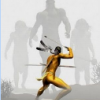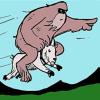Nothing wrong with you having some contentions regarding the existence of these animals but your arguments seem based on many generalizations and frankly, misinformation, which may be perpetuating some of your frustration. Let me see if I can help you out a little as I'm not going to waste time on all of them but I think your mentioning of FLIR aerial surveys deserves a response because some might find it interesting and I've done prior research in this area out of interest, since FLIR handhelds are my primary field tool.
First of all, average aerial surveys are conducted with camera-equipped craft at an altitude of 1,000-2,500 ft by transecting over selected land tracts and are primarily performed with respect to ungulate and cattle counts during specified hours. Right off the bat, we have a considerable parallel in the target species since both ungulates and especially cattle tend to congregate. Detection rates are close to 100% with FLIR aerial surveys on basic plains and with almost zero unobstructing foliage. For moderate and or hardwood cover that rate dips to 70-90%. Evergreen and dense cover, like majority of PNW which is covered with secondary is about 25-50%. Hence, FLIR aerial surveys are not done on animals like black bears and or other apex predators as an example, who mostly roam solitary and prefer dense habitat.
In the past, some Southeastern/Eastern states have made unsuccessful attempts with bears in areas with moderate foliage. Coyotes are another example of an animal not surveyed because of the unreliability of dense ground cover they habituate much of the time.
The target animals are distinguished by the FLIR scope operator (manually controlled) with a given GPS location. In most cases different animals possess different anticipated sizes as well as have distinct varying body heats. The most obvious ways of detection are in herding/congregation (as I already mentioned) combined with obvious location(s). Deer for example, are not usually solitary, so combined with size (most will be about the same) and specific heat signature, it's readily apparent what you are seeing. Improved resolution on equipment has many times helped to not only identify species, but development stage size within that target species. Once again, the predominant animals surveyed out of both interest and reliable identification are ungulates and cows.
Realistically for a sasquatch to be noticed as such by say, a FLIR helicopter, which is always possible "under the right circumstances," the animal would have to be caught absolutely in the clear. Why? Depending on area covered it could easily be mistaken for a human or a large quadruped if covered by even partial vegetative cover. BTW, vegetation and various foliage is not the only problematic cover with respect to unveiling a discernible living subject like a sasquatch, snow, angles of rock, cliffs, narrow riparian areas with deep creeks and even sparse vegetation would make identification extremely difficult. Not to mention, a sasquatch would need to be "interesting" enough to warrant a second look or be in a place or at a time to create further investigation. You know like " hey Bob, did you see that, what the hell is that hiker or hunter doing out or up there at this time?"
I'd be happy to work on some of your other misperceptions, but I'm packing to go participate in one of my biggest passions in life looking for more mythical monsters in a beautiful area. No worries, based on the substance of your arguments and the intelligence of many members here I'm sure you'll get a good education on actual habitat viability by the time I return.



